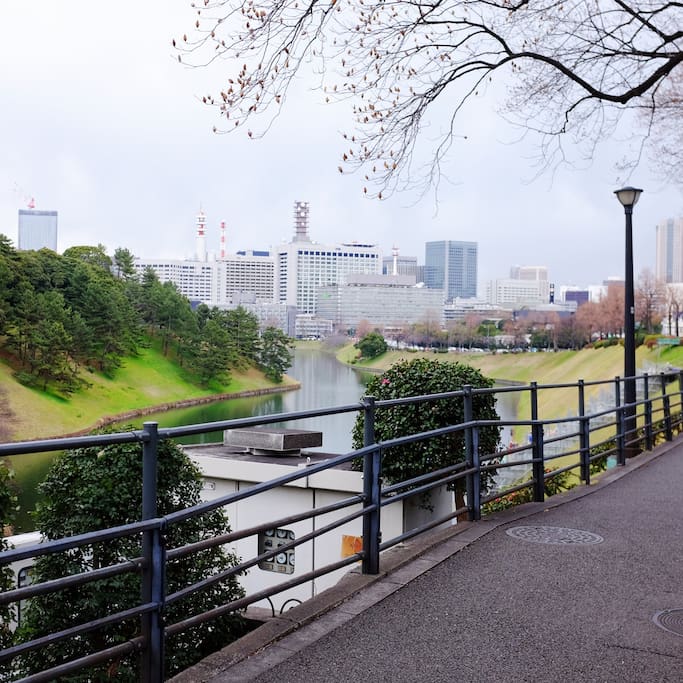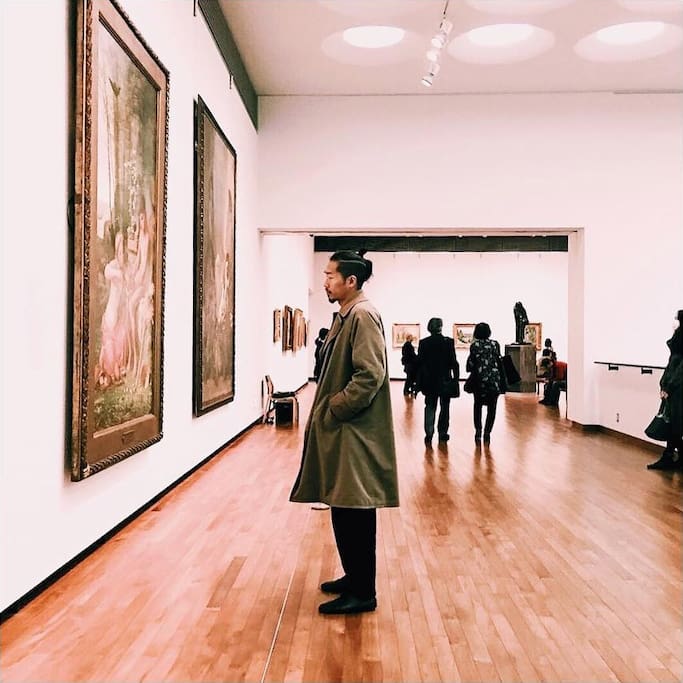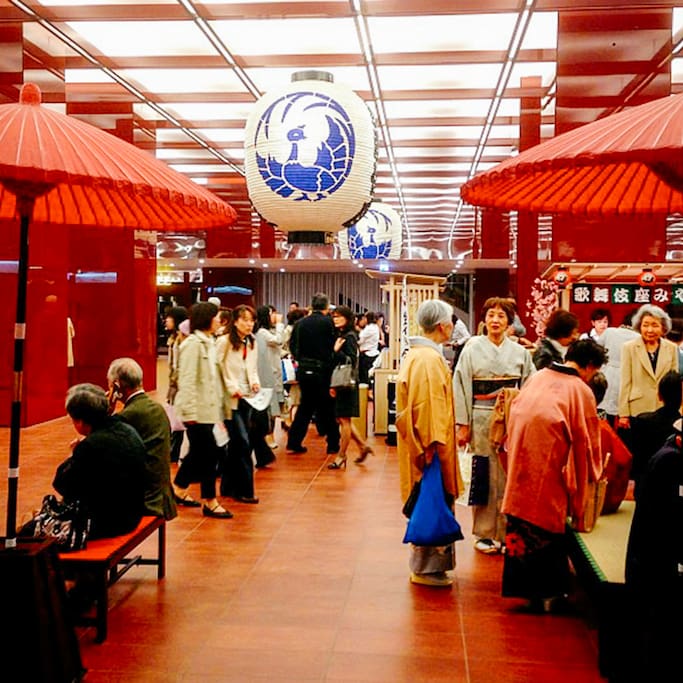Food Scene
日本料理なにわ Teppanyaki restaurant Naniwa
Traditional Japanese Restaurant
Jonathan's Kagurazaka Ekimae
109-2 Yaraichō24h Family Reataurant
Chinese Restaurant Royal Ryuho
1-chōme-1-104-19 TotsukamachiChinese Restaurant
Royal Host Otowa
1-chōme-15-15 OtowaFamily Restaurant.
Drinks & Nightlife
bar moon walk 西早稲田店
2-chōme-18-22 NishiwasedaBar
Shinjuku Comedy Club
2-chōme-2-2 YoyogiNightclub
メモリー
2 Chome-21 KabukichoNightclub
カラオケの鉄人 高田馬場店
1-chōme-26-12 TakadanobabaKaraoke
Sightseeing
Meiji Shrine (明治神宮 Meiji Jingū), located in Shibuya, is the Shinto shrine that is dedicated to the deified spirits of Emperor Meiji and his wife, Empress Shōken. The shrine does not contain the emperor's grave, which is located at Fushimi-momoyama, south of Kyoto.
1219 locals recommend
Meiji Jingu Treasure House
1-1 YoyogikamizonochōMeiji Shrine (明治神宮 Meiji Jingū), located in Shibuya, is the Shinto shrine that is dedicated to the deified spirits of Emperor Meiji and his wife, Empress Shōken. The shrine does not contain the emperor's grave, which is located at Fushimi-momoyama, south of Kyoto.
The Tsukiji Market (築地市場 Tsukiji shijō), supervised by the Tokyo Metropolitan Central Wholesale Market (東京都中央卸売市場 Tōkyō-to Chūō Oroshiuri Shijō) of the Tokyo Metropolitan Bureau of Industrial and Labor Affairs, is the biggest wholesale fish and seafood market in the world and also one of the largest wholesale food markets of any kind.
築地 市場めし 池袋店
1-chōme-28-1 MinamiikebukuroThe Tsukiji Market (築地市場 Tsukiji shijō), supervised by the Tokyo Metropolitan Central Wholesale Market (東京都中央卸売市場 Tōkyō-to Chūō Oroshiuri Shijō) of the Tokyo Metropolitan Bureau of Industrial and Labor Affairs, is the biggest wholesale fish and seafood market in the world and also one of the largest wholesale food markets of any kind.
The Tokyo Imperial Palace (皇居 Kōkyo, literally "Imperial Residence") is the primary residence of the Emperor of Japan. It is a large park-like area located in the Chiyoda ward of Tokyo and contains buildings including the main palace (宮殿 Kyūden), the private residences of the Imperial Family, an archive, museums and administrative offices.
377 locals recommend
Imperial Palace
1-1 ChiyodaThe Tokyo Imperial Palace (皇居 Kōkyo, literally "Imperial Residence") is the primary residence of the Emperor of Japan. It is a large park-like area located in the Chiyoda ward of Tokyo and contains buildings including the main palace (宮殿 Kyūden), the private residences of the Imperial Family, an archive, museums and administrative offices.
Tokyo Skytree (東京スカイツリー Tōkyō Sukaitsurī) is a broadcasting, restaurant, and observation tower. It became the tallest structure in Japan in 2010 and reached its full height of 634.0 metres (2,080 ft) in March 2011, making it the tallest tower in the world, displacing the Canton Tower, and the second tallest structure in the world after the Burj Khalifa (829.8 m/2,722 ft).
1847 locals recommend
Tokyo Skytree
1-chōme-1-2 OshiageTokyo Skytree (東京スカイツリー Tōkyō Sukaitsurī) is a broadcasting, restaurant, and observation tower. It became the tallest structure in Japan in 2010 and reached its full height of 634.0 metres (2,080 ft) in March 2011, making it the tallest tower in the world, displacing the Canton Tower, and the second tallest structure in the world after the Burj Khalifa (829.8 m/2,722 ft).
Asakusa Shrine (浅草神社 Asakusa-jinja), also known as Sanja-sama ("Shrine of the Three gods"), is one of the most famous Shinto shrines in Tokyo. Located in Asakusa, the shrine honors the three men who founded the Sensō-ji.
41 locals recommend
Asakusa Shrine
2-chōme-3-1 AsakusaAsakusa Shrine (浅草神社 Asakusa-jinja), also known as Sanja-sama ("Shrine of the Three gods"), is one of the most famous Shinto shrines in Tokyo. Located in Asakusa, the shrine honors the three men who founded the Sensō-ji.
Tokyo Dome's original nickname was "The Big Egg", with some calling it the "Tokyo Big Egg". Its dome-shaped roof is an air-supported structure, a flexible membrane supported by slightly pressurizing the inside of the stadium.
172 locals recommend
Tokyo Dome
1-chōme-3-61 KōrakuTokyo Dome's original nickname was "The Big Egg", with some calling it the "Tokyo Big Egg". Its dome-shaped roof is an air-supported structure, a flexible membrane supported by slightly pressurizing the inside of the stadium.
Parks & Nature
Hibiyakoen
Japanese traditional city park.
Large park in the middle of Shinjuku. Really quiet at night, good for a walk.
457 locals recommend
Shinjuku Chuo Park
2-chōme-11 NishishinjukuLarge park in the middle of Shinjuku. Really quiet at night, good for a walk.
Ueno Park (上野公園 Ueno Kōen) is a spacious public park in the Ueno district of Taitō, Tokyo, Japan. The park was established in 1873 on lands formerly belonging to the temple of Kan'ei-ji. Amongst the country's first public parks, it was founded following the western example as part of the borrowing and assimilation of international practices that characterizes the early Meiji period. The home of a number of major museums, Ueno Park is also celebrated in spring for its cherry blossoms and hanami.
314 locals recommend
Uenokoen
Ueno Park (上野公園 Ueno Kōen) is a spacious public park in the Ueno district of Taitō, Tokyo, Japan. The park was established in 1873 on lands formerly belonging to the temple of Kan'ei-ji. Amongst the country's first public parks, it was founded following the western example as part of the borrowing and assimilation of international practices that characterizes the early Meiji period. The home of a number of major museums, Ueno Park is also celebrated in spring for its cherry blossoms and hanami.
Shinjuku Gyoen National Garden (新宿御苑 Shinjuku Gyoen) is a large park and garden in Shinjuku and Shibuya. It was originally a residence of the Naitō family in the Edo period. Afterwards, it became a garden under the management of the Imperial Household Agency of Japan. It is now a national park under the jurisdiction of the Ministry of the Environment.
2181 locals recommend
Shinjuku Gyoen National Garden
11 NaitōmachiShinjuku Gyoen National Garden (新宿御苑 Shinjuku Gyoen) is a large park and garden in Shinjuku and Shibuya. It was originally a residence of the Naitō family in the Edo period. Afterwards, it became a garden under the management of the Imperial Household Agency of Japan. It is now a national park under the jurisdiction of the Ministry of the Environment.
Arts & Culture
The National Museum of Western Art (国立西洋美術館 Kokuritsu Seiyō Bijutsukan) is the premier public art gallery in Japan specializing in art from the Western tradition.
246 locals recommend
National Museum of Western Art
7-7 UenokōenThe National Museum of Western Art (国立西洋美術館 Kokuritsu Seiyō Bijutsukan) is the premier public art gallery in Japan specializing in art from the Western tradition.
The Tokyo National Museum (東京国立博物館 Tōkyō Kokuritsu Hakubutsukan), or TNM, established in 1872, is the oldest Japanese national museum, the largest art museum in Japan and one of the largest art museums in the world.
206 locals recommend
Tokyo National Museum
13-9 UenokōenThe Tokyo National Museum (東京国立博物館 Tōkyō Kokuritsu Hakubutsukan), or TNM, established in 1872, is the oldest Japanese national museum, the largest art museum in Japan and one of the largest art museums in the world.
The Ghibli Museum (三鷹の森ジブリ美術館 Mitaka no Mori Jiburi Bijutsukan, Mitaka Forest Ghibli Museum) is a museum showcasing the work of the Japanese animation studio Studio Ghibli.
749 locals recommend
Ghibli Museum
1-chōme-1-83 ShimorenjakuThe Ghibli Museum (三鷹の森ジブリ美術館 Mitaka no Mori Jiburi Bijutsukan, Mitaka Forest Ghibli Museum) is a museum showcasing the work of the Japanese animation studio Studio Ghibli.
Kabuki-za (歌舞伎座) in Ginza is the principal theater in Tokyo for the traditional kabuki drama form. The Kabuki-za was originally opened by a Meiji era journalist, Fukuchi Gen'ichirō.
404 locals recommend
Kabukiza Tower
4-chōme-12-15 GinzaKabuki-za (歌舞伎座) in Ginza is the principal theater in Tokyo for the traditional kabuki drama form. The Kabuki-za was originally opened by a Meiji era journalist, Fukuchi Gen'ichirō.
Shopping
Isetan Shinjuku Store
3-chōme-14-1 ShinjukuBig department store
Takashimaya Shinjuku
5-chōme-24-2 SendagayaBig department store
Big electrical store and UNIQLO which is a cloth shop
311 locals recommend
Yodobashi Camera Shinjuku West Main Store
1-chōme-11-1 NishishinjukuBig electrical store and UNIQLO which is a cloth shop
Keio department store stocks a wide range of Japanese cosmetic brands. Directly connected to Shinjuku Station.
140 locals recommend
Keio Department Store Shinjuku
1-chōme-1-4 NishishinjukuKeio department store stocks a wide range of Japanese cosmetic brands. Directly connected to Shinjuku Station.
Seibu Ikebukuro
1-chōme-28-1 MinamiikebukuroBig department store
Essentials
7-Eleven
4-chōme-7-17 MotoasakusaSeven-Eleven open 24hours
ローソン 新宿山吹町店
265-6 YamabukichōLawson open 24hours
My Basket
5-chōme-11-22 ShinjukuSupermarket
FamilyMart
6-chōme-38-11 HigashinipporiFamilyMart open 24hours































